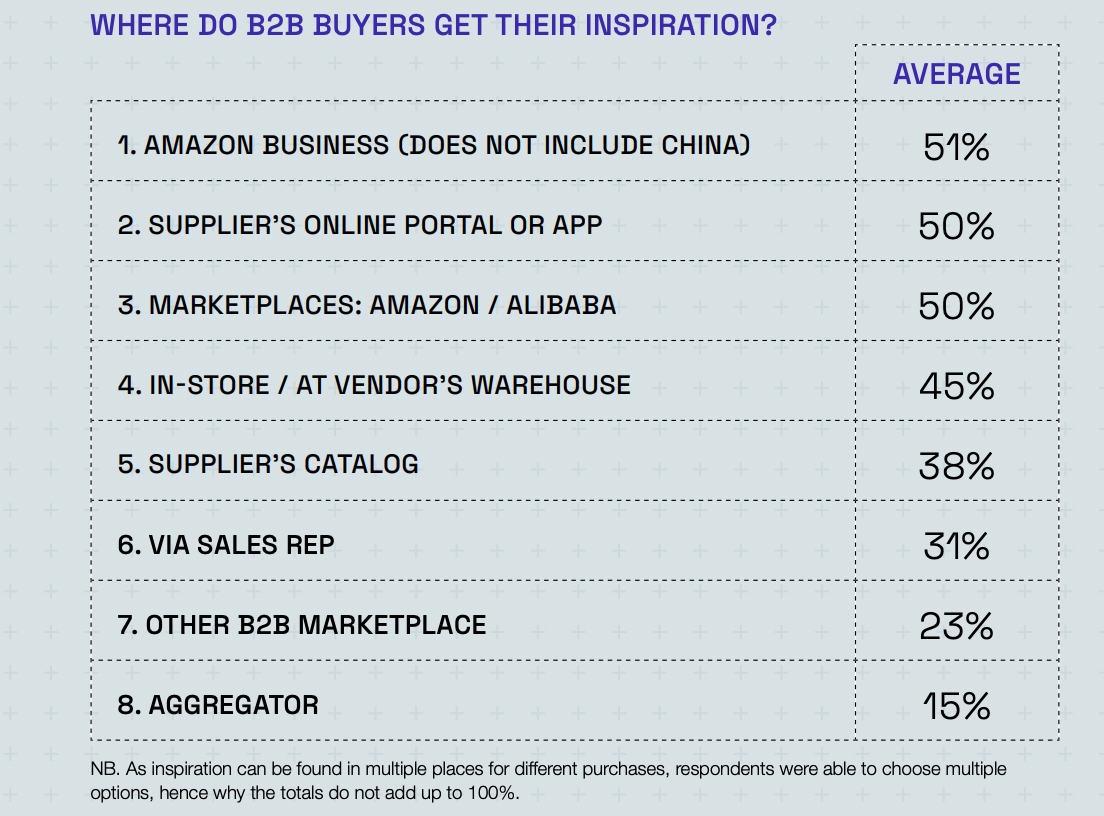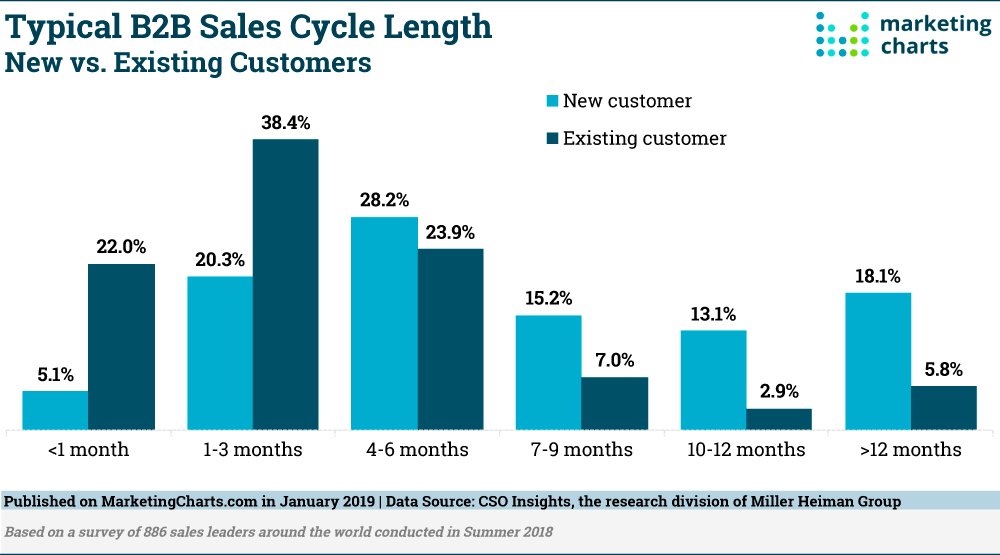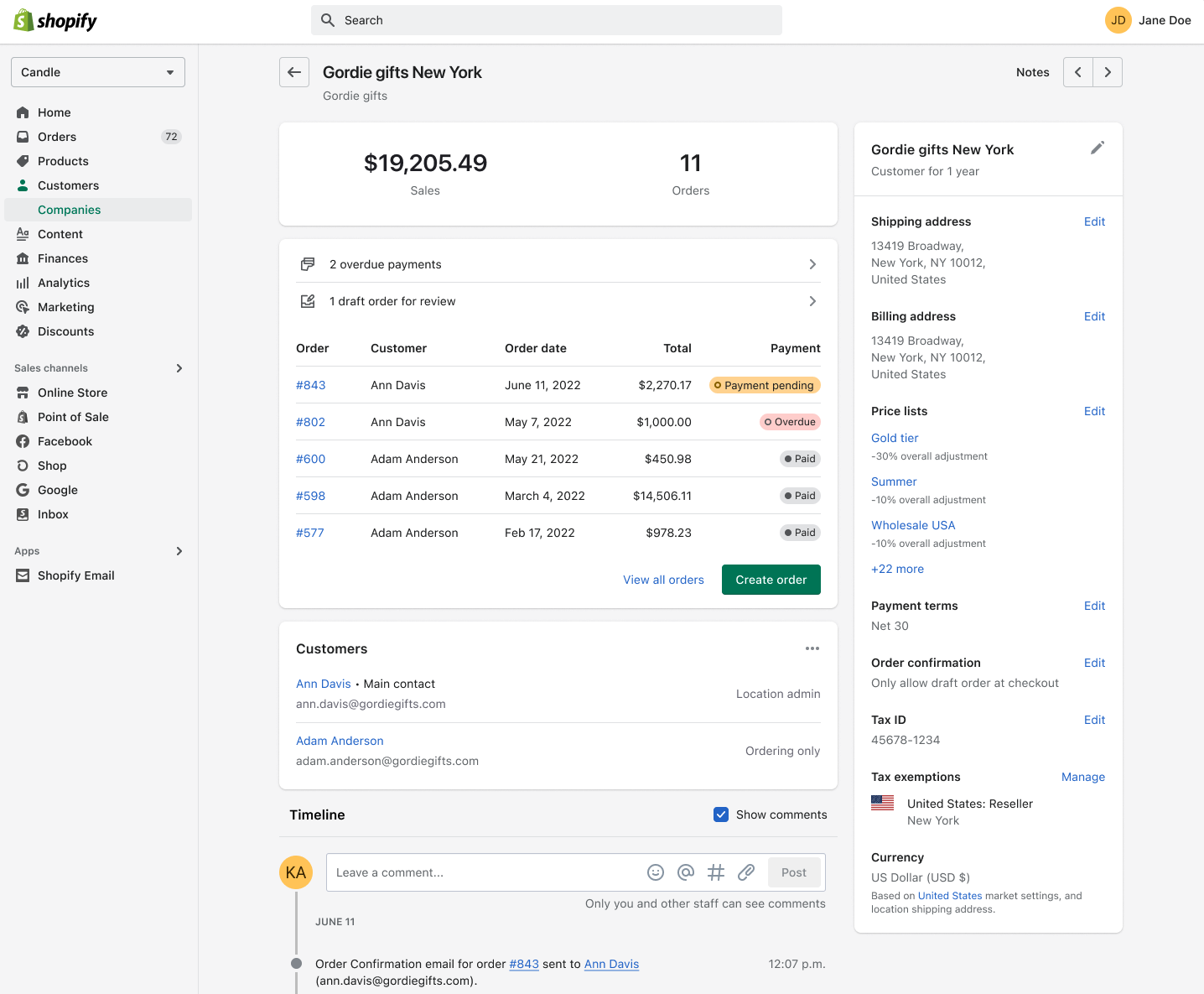When B2B brands purchase goods online, there’s a lot of thought that goes into their purchase decision. Just one poorly targeted sales or marketing campaign could deter potential customers from signing on the dotted line.
A sales funnel outlines key stages in the buyer’s journey. By understanding the frame of mind a buyer is in at each stage, both sales and marketing teams deliver the right message at the right time, and improve overall conversion rates.
So, what does a B2B sales funnel look like? Here’s how to use the B2B sales funnel model to personalize your marketing strategy and guide new customers towards making a purchase.
What is a B2B sales funnel?
A B2B sales funnel is a process all buyers move through when making purchasing decisions on behalf of a company. Often referred to as a sales pipeline, it’s a visual representation of how prospective buyers navigate through the buyer’s journey.
5 B2B sales funnel stages
The B2B sales funnel can vary from industry to industry. Buyers can also jump from one stage to the next, especially if they discover content sooner than expected, or if the need to purchase becomes urgent.
However, we can break down the typical B2B sales funnel into five key stages.
1. Awareness stage
When a business buyer is aware of a problem they’d like to solve, they enter the top of the sales funnel. At this point, buyers aren’t necessarily looking for a solution. They’re simply aware of a pain point, hence why it’s referred to as the awareness stage.
2. Interest stage
Once a buyer demonstrates an interest in solving the problem, they progress into the next stage of the B2B sales funnel. This is where they discover products likely to solve their problem, or brainstorm a list of necessary features their next purchase needs to include. They haven’t identified any suppliers just yet.
3. Consideration stage
Business buyers reach the consideration stage when they’re actively searching for a supplier to solve their problem. Popular activities during this stage include browsing B2B marketplaces like Faire, requesting brochures from potential vendors, and asking for referrals from retail partners.

Caption: Gorilla Group found Amazon Business was the most popular place for B2B buyers to get their inspiration when searching for new products.
4. Evaluation stage
Buyers with a shortlist of potential suppliers reach the evaluation stage. At this point, they’ve chosen several suppliers with the ability to solve their problem. Your job is to convince key stakeholders in the B2B buying process that you’re the best company for the job.
5. Purchase stage
Once businesses have signoff from key stakeholders in their organization, they choose a supplier and make their purchase.
The difference between B2C and B2B sales funnels
The sales funnel for B2B and business-to-consumer (B2C) businesses have some overlap. Buyers pass through the same stages, though the biggest differences between the two include:
More decision-makers. Gartner reports the average B2B purchase decision involves up to 10 different people. It’s possible for each one to pass through each stage of the sales funnel at different times.
Longer sales cycles. Because more decision-makers are involved in the B2B buying decision, it takes much longer (sometimes up to 12 months) for a business customer to pass through the sales funnel. Some may be stuck in the evaluation stage for weeks if they’re unable to get the green light from a stakeholder.
Hand-holding and support. Despite the fact that just 17% of B2B customers’ time in the sales process is spent with a support representative, there’s greater pressure on B2B buyers to make the right decision. Expect to provide more hand-holding support to buyers, who often want to know how they can resell your product to their own customers (rather than use it themselves).
Take it from Will Stewart, owner of Cedar Spring Recreation, who says, “For us, B2B ecommerce is a longer and more traditional sales cycle and needs more resources upfront to work effectively.
“For example, B2C sales may require some social proof and enough trust for a customer to make an initial purchase, whereas our B2B customers may need to see or try our products and then need to have more extensive product information for their sales teams to be able to effectively sell our products on their own.”

How to guide buyers through the B2B sales funnel
We know the B2B sales funnel has many stages a lead needs to pass through before becoming a paying customer. The real question is: How can you guide potential B2B customers throughout the process without draining your resources—or worse, being too overpowering and causing them to abandon a purchase?
Identify what stage they’re at
To give the right support to a potential customer, first identify what stage of the B2B sales funnel they’re currently in.
As Clare Holden, founder of White Night, explains, “A buyer for a multi-brand store will generally never place an order with a brand they haven't stocked before having seen the product in person. It is too risky for them. They are not just buying one piece but various styles and sizes, so it is generally essential to participate in a showroom or a trade show so buyers can see the product in person.
“At tradeshows, the buyers are generally under a tight schedule. This is probably the biggest clue as to what stage the buyer is at. If they are really interested, they will make time for you. If they come and have a look, you may be on their radar but they are not willing to place an order yet. They might be waiting to see how you sell and grow without making a commitment.”
The advantage of taking your B2B business online is that you have greater visibility over the touchpoints a potential buyer is having with your company. Get insight into:
The SKUs they’re viewing
Which emails they’re opening
The landing pages they’re visiting (such as delivery policies, which indicates fast delivery as a criteria new suppliers must meet)
How often they return to your website
Which areas of the page they dwell on the longest (using heat maps or scroll depth reports)
Compile this insight with a B2B lead nurturing tool like Leadfeeder or ZoomInfo. It’ll tie website activity (even if the company hasn’t yet created a wholesale account), so you can accurately forecast your B2B sales pipeline and recognize qualified leads.
Divert in-person prospects online
The traditional way of selling to business customers heavily involved cold calling, trade shows, and manual invoicing. But taking your B2B business online can be a strong value proposition.
Experts predict 17% of B2B sales will be generated digitally in 2023. As a result, research shows that nine in 10 global B2B buyers expect DTC-style experiences. Yet more than half are frustrated with the online buying experience offered by suppliers.
"We are running our B2B sales through Shopify. All of the payments go through our Shopify store. That allows us to keep track of our stock effectively, keep our accounting clean, and to have a seamless, electronic payment gateway for our B2B purchases.”
—Dr. Justine Ward, co-founder and CMO of Thirdzy
As White Night’s Clare Holden says, “Trade shows are generally held twice a year, so if they don't buy, it may be another six months until you get the chance to sell to them again.
“With ecommerce, someone might see your product on social media, have a browse on your website then come back a few days later to purchase. Sometimes buyers will have seen your product in a magazine or on socials and get in contact. This is the best-case scenario, as you know they are open to buy and you have already piqued their interest.”
Once you’ve identified the stage of the sales process a prospect is lingering within, try to divert them to your online store. Shopify’s B2B ecommerce platform allows you to do the following, all from the same back end that powers your B2C storefront:
Schedule marketing campaigns to nurture prospective buyers at scale
Showcase wholesale price lists behind a password-protected portal
Assign custom payment terms for B2B customers
Invite stakeholders to register under a company profile to quickly sign-off on purchase decisions
“One of the biggest priorities for us was to make sure both parts of the business—D2C and B2B—felt unified. Same brand, same website, same quality, and most importantly same service. The biggest mistake I think companies make is trying to separate the two. The more a company can integrate both types of offerings, the better off they will be in the long term!”
—Colin Barceloux, CEO of Lively Root

The secret to taking B2B prospects online mid-funnel is to provide an incentive—be that a free sample, discount on their first order, or promise of speedy delivery, since manual fulfillment processes don’t slow you down.
Kelly Van Arsdale, co-founder and CEO of Spinnaker Chocolate, says, “We typically start by cold emailing prospective customers. We have a pretty good idea of who we think will be interested, given the price point of our product. If they’re interested, we send them a few samples of our chocolate and follow up a week or so later.
“If they are excited about the samples, we share access to an online page with our wholesale pricing and process. Assuming they’re still interested, we ask them to fill out a quick form and then send an activation email to our password-protected online wholesale store, where they can place orders for our wholesale-specific products.”
Produce on-demand content for each stage of the funnel
Employ digital marketing campaigns to resolve the queries a prospective customer has as they pass through each stage of the sales funnel. Gartner found B2B customers who received helpful information across their buying jobs were 2.8 times more likely to experience purchase ease. They were also three times less likely to regret big purchase decisions.
This is where a personalized approach to B2B sales pays off—the type of content a buyer is most likely to engage with differs depending on the stage of the funnel they’re currently in.
We can break this down into three main categories:
Top of the funnel. At this stage, the focus isn’t on your brand or products. Content should be angled around the problem someone is facing when they first begin to look for a solution, formatted as educational webinars, blog posts, YouTube videos, or social media posts.
Middle of the funnel. When a B2B buyer is in the middle of the sales funnel, they’re looking for suppliers they trust to solve their problem. Build trust with prospective buyers through content marketing campaigns, such as blog posts, case studies, or whitepapers, which demonstrate your knowledge and product quality.
Bottom of the funnel. Consolidate the fact you’re the best supplier with white papers that explain your product USPs, testimonials from previous B2B buyers, and case studies that profile exactly how previous customers have achieved the same goal with your products.
Don’t expect prospective buyers to discover this content on their own accord. Use Shopify Flow’s ecommerce automation functionality to proactively provide content to customers based on the actions they’ve made.
If a B2B buyer views your landing page, for example, create a workflow that sends a relevant case study five days later. Or, two weeks after creating a company profile, automatically schedule a welcome email that introduces the B2B sales representative they can reach out to, should they have any questions.
The more you automate with tools like Flow, the more money a business can make. It’s allowed us to run three Shopify stores without hiring an employee for each one.”
—Julio Giannotti, web manager at Scandinavian Designs
Offer sales rep support
Despite the fact that just over a quarter of a B2B buyer’s time is spent with a salesperson, contacting a prospective customer has a profound impact on their likelihood of making a purchase.
Buyers often take months to pass through the B2B sales funnel. Unanswered questions make the process much slower than it needs to be. It’s why Clare Holden of White Night says, “It's essential you are prepared for any questions buyers have along the way.
“They will want to know the details about everything: where you manufacture, lead times, suppliers, order quantities, scalability, what your marketing plan as a brand is, sales terms, delivery dates—you need to ensure you are prompt and ready with all the information they need. If you hesitate with any of these, they may lose confidence in your ability.”
Employ a B2B sales team to support a leads’ decision-making, should they require extra help. This could be:
Live chat
Email outreach
Traditional phone calls
Note that every interaction doesn’t need to be a sales pitch. The aim is to uncover the hurdle that’s preventing a buyer from progressing to the next stage of the sales funnel and resolving it—subtly mentioning how your product(s) makes that possible.
Customer relationship management (CRM) tools like HubSpot, Reamaze, and Endear integrate with Shopify Plus, so you can easily reference previous interactions with each potential customer. It’ll help fine-tune future communication and deliver content a customer needs, without forcing them to ask twice—even if they’re speaking with a different salesperson each time.
We now have customers willing to place $50,000+ orders online on their own with minimal to no hand-holding by reps. If you can get large B2B AOVs with low sales overhead, you can build a pretty profitable business.”
—Michael Martocci, founder of SwagUp
Don’t forget about post-purchase
The B2B sales funnel doesn’t conclude when a buyer has made their first purchase. Get the first interaction right and there’s a good chance your B2B customers will return to buy again. It’s these repeat customers that drive 44% of a company’s revenue.
Encourage retention by building strong relationships with your customers. Again, most of this can be automated:
Schedule post-purchase emails that contain personalized product recommendations similar to the items they’ve already purchased.
Help retailers sell your inventory by sharing display ideas, emerging trends in the industry, and unique selling points to cover in product descriptions.
Invite existing customers to connect with you in real life when you’re presenting at industry events or trade shows.
Highlight them as a recommended supplier or retail partner across social media. This will help solve one of the biggest recurring problems for retailers: generating brand awareness.
B2C is mostly reliant on direct response ads and social media content. B2B is more about relationships between the sales team and buyers at retail stores. We have a sales team who builds and nurtures those relationships.”
—Meredith Erin, CEO of Boredwalk
Optimize your B2B sales funnel to improve profitability
The less time prospective buyers spend in the B2B sales funnel, the more profit your company will generate.
By taking your B2B business online, customers can self-serve and absorb content on their own terms. Automate as much of the process as possible, proactively delivering useful information based on the actions they’ve completed.
Buyers who feel confident in making their first purchase will do so sooner. Not only does that impact your bottom line, it frees up time for sales representatives to spend on higher value deals and prospects that need hand-holding through the decision process.
Need help processing B2B sales online? With decades of combined experience selling to B2B customers, Shopify Plus is here to help.
B2B sales funnel FAQ
How do you optimize a B2B sales funnel?
Schedule content based on key triggers or touchpoints.
Automate email marketing campaigns for each stage.
Offer B2B sales rep support.
Build trust with social proof and trust signals.
Engage with buyers post-purchase.
How do you make a B2B funnel?
Build your buyer personas.
Define your customer journey map.
List the actions included in a B2B buying decision.
Explain who is involved in each touchpoint.
Group actions into different stages of the funnel.
What is the difference between a B2B marketing funnel and sales funnel?
B2B sales and marketing funnels are often confused. The main difference is that a sales funnel contains the steps a buyer takes before making a purchase. A marketing funnel is the delivery of content that supports each stage.
What are the stages of a B2B funnel?
Awareness
Interest
Consideration
Evaluation
Purchase
Read more
- B2B Ecommerce: Everything You Need to Know to Get Started
- B2B Ecommerce: Why Taking Your B2B Business Online is a Smart Strategy to Scale
- 12 B2B Ecommerce Trends To Shape Your Business in 2023
- What Is Wholesale B2B and How To Sell To Customers in 2023
- What Are B2B Payments? Methods & Processing Systems
- B2B Marketplaces: What They Are, How to Succeed, and 8 Marketplaces to Consider
- Find the perfect domain name
- How is B2B on Shopify Different From the Plus Wholesale Channel? A Quickstart Guide to Selling B2B on Shopify
- DTC and Wholesale in One Platform—and One Store





